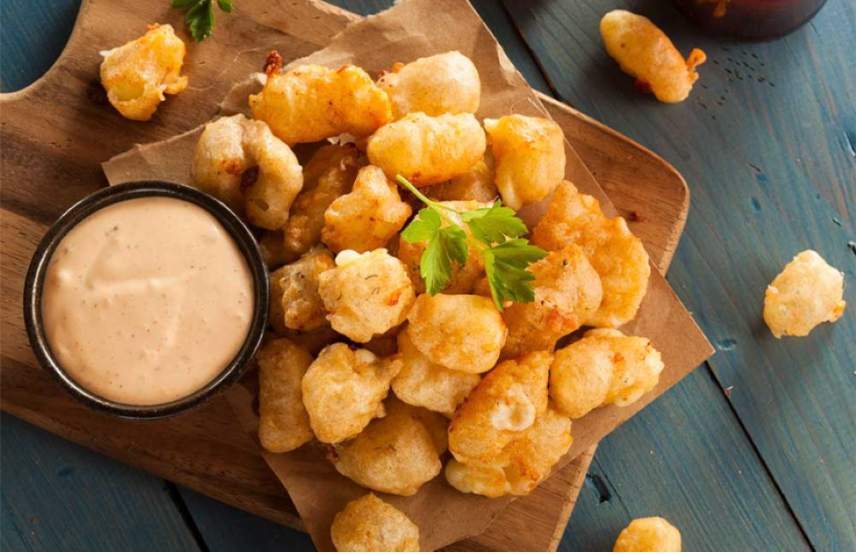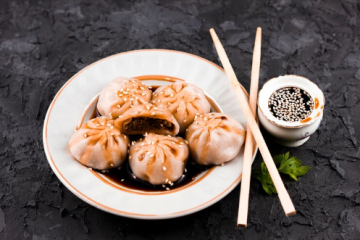Deep-fried cheese curds are a delectable treat, beloved by many for their crispy exterior and gooey, melty interior.
While they may seem like a simple snack, there is fascinating science behind why cheese curds are particularly well-suited for frying. This article delves into the specifics of cheese curds’ melting point and the role of the batter in achieving that perfect texture.
Cheese Melting Point
The Unique Properties of Cheese Curds
Cheese curds are the fresh, young form of cheese, typically cheddar, that are separated from the whey during the cheese-making process.
They have a springy texture and a mild flavor, often described as “squeaky” when bitten into fresh. But what makes a deep fried cheese curd recipe so perfect is the unique composition of moisture and protein in the cheese curds..
Moisture Content
Cheese curds have a higher moisture content compared to aged cheese. This moisture plays a critical role in how the curds react to heat.
When heated, the water content in the curds turns into steam. In aged cheeses, lower moisture content means that the cheese is more likely to melt and spread when heated.
In contrast, the higher moisture in cheese curds helps them maintain their shape when subjected to the high temperatures of frying.
Protein Structure
The protein structure in cheese curds is another crucial factor. Fresh curds have a more elastic protein matrix because they haven’t undergone the extensive fermentation and aging processes that other cheeses have.
This elastic protein network allows the curds to soften and become gooey when heated without completely breaking down and losing their form.
This property is essential for achieving the desirable melty interior without the curds turning into a liquid mess in the fryer.
The Science of Melting Points
Cheese curds have a relatively high melting point compared to other cheeses. This is due to the combination of their moisture content and protein structure.
The melting point of cheese is influenced by factors such as fat content, acidity, and the presence of emulsifiers.
In the case of cheese curds, their balanced composition ensures that they melt just enough to become soft and gooey but not so much that they lose their shape entirely.
Crispy Coating
The Role of Batter
The batter is not just a delicious outer layer but also a crucial element in the frying process. It acts as a barrier, protecting the cheese curds from direct contact with the hot oil.
This barrier allows the curds to heat up gradually, promoting even melting and preventing the curds from oozing out into the oil.
Batter Composition
A typical batter for deep-frying cheese curds may include flour, eggs, milk or beer, and seasonings. Each component of the batter has a specific role:
- Flour: Provides the structural foundation for the batter, creating a solid coating that crisps up during frying.
- Eggs: Add richness and help bind the flour to the cheese curds.
- Milk or Beer: Contributes to the batter’s consistency and flavor. Beer, with its carbonation, can create a lighter, crispier texture.
- Seasonings: Enhance the flavor of the batter and, consequently, the cheese curds.
The Frying Process
When cheese curds coated in batter are dropped into hot oil, several scientific processes occur:
- Heat Transfer: The oil conducts heat to the batter, causing it to cook and harden into a crispy shell. The batter’s ingredients undergo Maillard reactions, a series of chemical reactions between amino acids and reducing sugars, which give the coating its golden-brown color and complex flavor.
- Moisture Barrier: The batter forms a barrier that prevents the oil from penetrating the cheese curds. This barrier also traps steam inside, which helps cook the curds evenly.
- Steam Formation: As the curds heat up, the moisture inside them turns to steam. This steam helps soften the curds without breaking down their protein structure completely.
Achieving the Perfect Texture
The goal when frying cheese curds is to achieve a contrast between the crispy exterior and the gooey interior. This requires precise control of the frying conditions:
- Oil Temperature: The oil should be heated to around 375°F (190°C). If the oil is too hot, the batter will burn before the curds are heated through. If it’s not hot enough, the curds may become greasy and the batter soggy.
- Frying Time: Typically, cheese curds need to be fried for just 1-2 minutes. This brief period is sufficient to cook the batter and melt the curds inside without overcooking them.
Practical Tips for Perfect Deep-Fried Cheese Curds
Choosing the Right Curds
For the best results, use fresh cheese curds. Fresh curds have the optimal moisture and protein content for frying. They should be slightly springy to the touch and produce a squeaking sound when bitten into.
Preparing the Batter
- Consistency: The batter should be thick enough to coat the curds evenly but not so thick that it clumps. Adjust the amount of liquid (milk or beer) to achieve the right consistency.
- Flavoring: Don’t be afraid to experiment with seasonings in the batter. Common additions include garlic powder, paprika, and cayenne pepper for a bit of heat.
Frying Technique
- Batch Size: Fry the curds in small batches to avoid overcrowding the fryer, which can lower the oil temperature and result in uneven cooking.
- Draining: After frying, place the curds on a paper towel-lined plate to drain excess oil. This helps maintain their crispiness.
The Chemistry of Cheese Curds and Batter Interaction
Fat and Emulsifiers
Cheese curds contain fat, which influences their melting properties. During frying, the fat in the curds starts to melt, adding to the gooey texture.
Emulsifiers present in the curds, such as casein, help maintain a stable emulsion, preventing the fat from separating completely. This stability is crucial for ensuring that the curds become creamy rather than oily when heated.
Maillard Reactions in Batter
The batter undergoes Maillard reactions during frying, which are essential for flavor development and color.
These reactions occur between amino acids and reducing sugars at high temperatures, leading to the formation of complex flavor compounds and a golden-brown crust.
The presence of eggs in the batter enhances these reactions, contributing to the desirable crispy texture.
Understanding Oil Dynamics
Oil Selection
Choosing the right oil is vital for successful deep frying. Oils with high smoke points, such as canola, peanut, or vegetable oil, are ideal because they can withstand the high temperatures needed for frying without breaking down and producing off-flavors.
Maintaining Oil Quality
- Temperature Control: Keeping the oil at a consistent temperature is crucial. Use a thermometer to monitor the oil and adjust the heat as necessary.
- Oil Lifespan: Over time, frying oil can degrade, especially if food particles are left in it. Strain the oil after each use and replace it regularly to maintain the quality of your fried cheese curds.
The Sensory Experience
Texture Contrast
The appeal of deep-fried cheese curds lies in the contrast between the crunchy exterior and the soft, gooey interior. This textural interplay creates a satisfying sensory experience that makes each bite enjoyable.
Flavor Enhancement
The frying process not only alters the texture but also enhances the flavor of the cheese curds. The batter adds savory notes and a hint of saltiness, while the Maillard reactions contribute a rich, toasty flavor.
When paired with dipping sauces, the flavor profile of the curds can be further elevated, creating a dynamic taste experience.
Summarizing
The science behind frying cheese curds reveals the careful balance of moisture, protein, and batter composition required to achieve the perfect snack. The unique properties of cheese curds make them ideal for frying, allowing them to melt just enough to become gooey without losing their shape. The batter serves as a protective and transformative layer, creating a crispy exterior that contrasts beautifully with the melted curds inside. Understanding these scientific principles can help anyone master the art of making deep-fried cheese curds, ensuring a delightful culinary experience with every bite.



